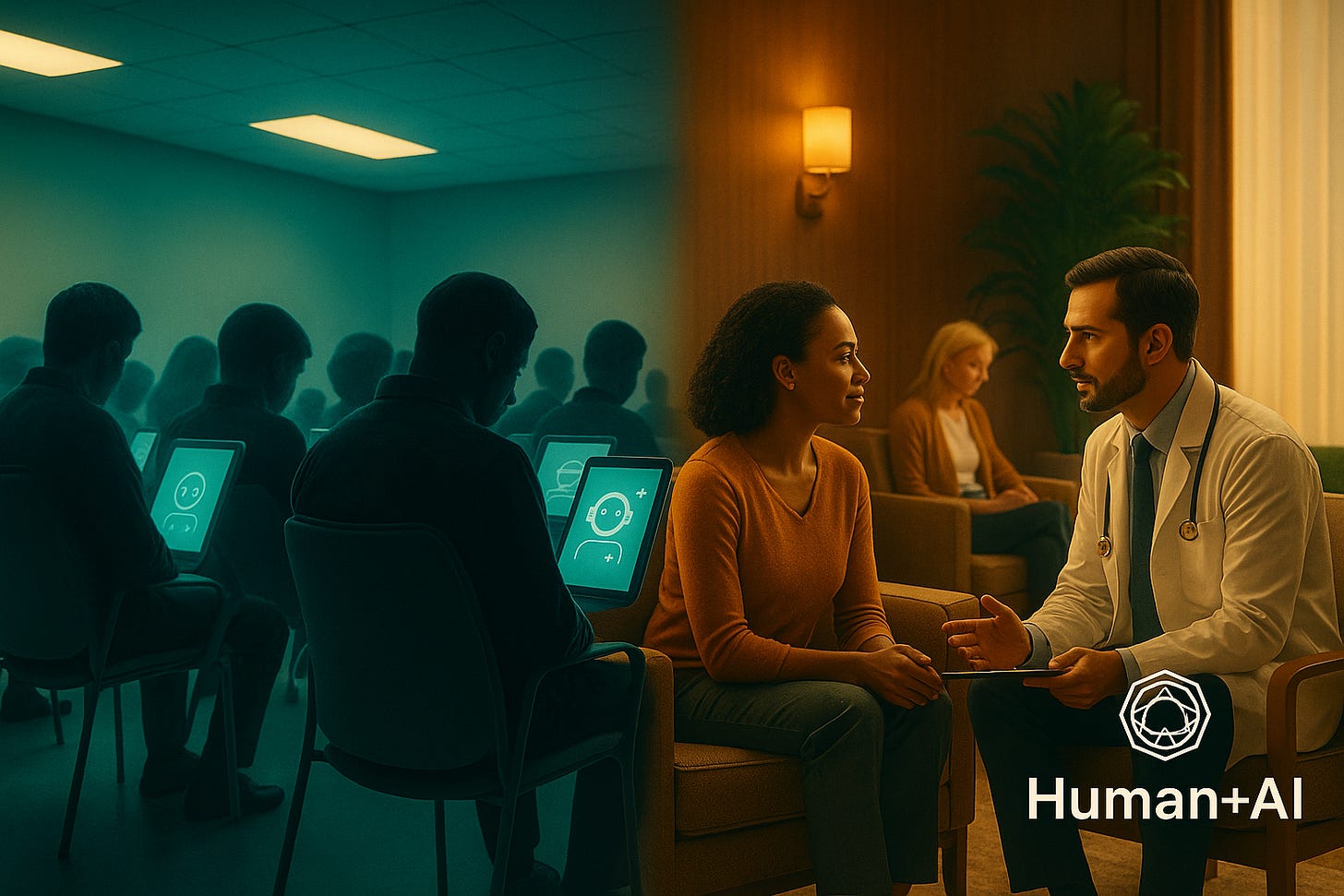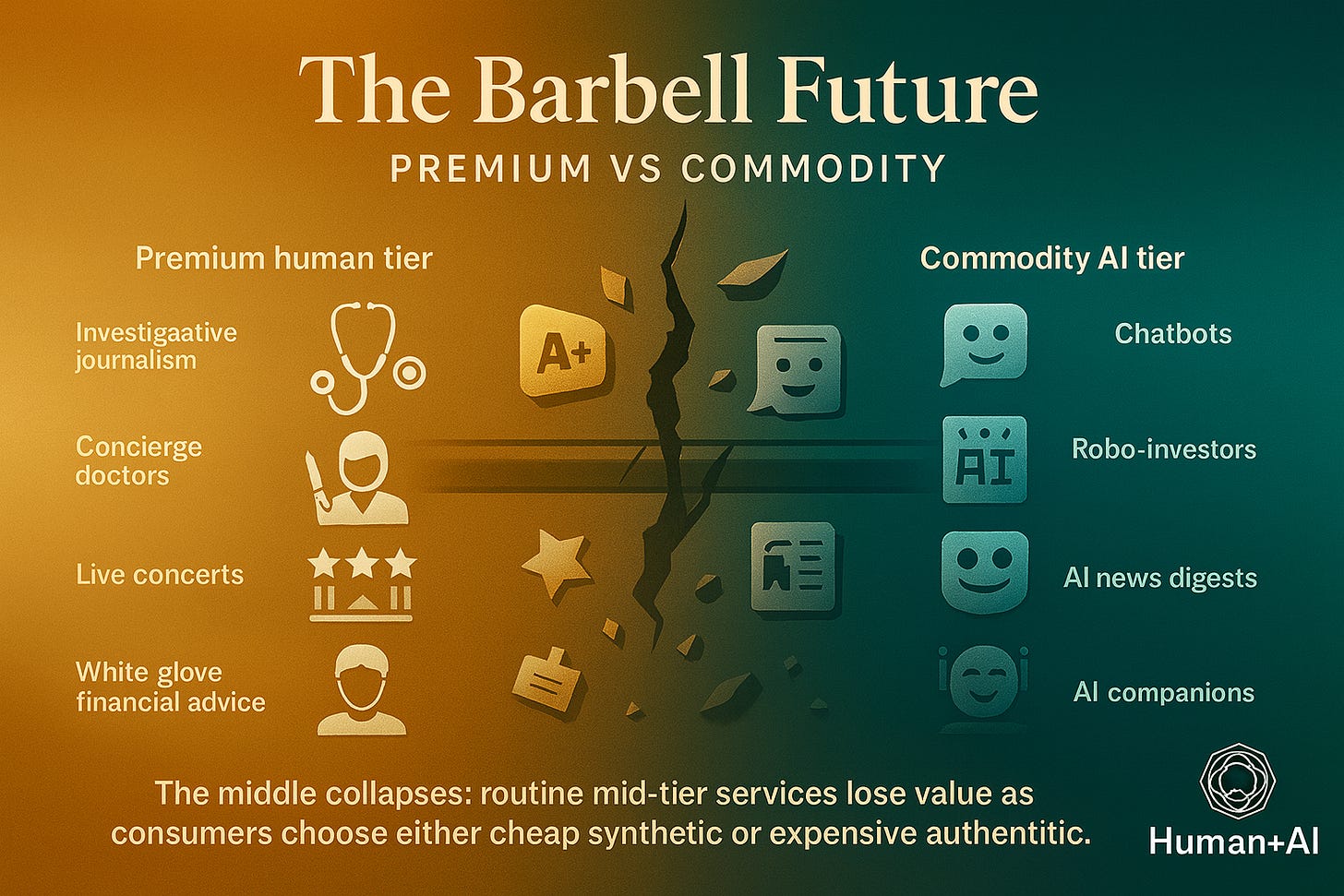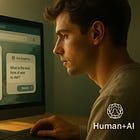Would you pay for human connection?
If AI makes information and interaction cheap and abundant, everything “real”, from trusted news to doctors, tutors, and dating, becomes a luxury.
About a year ago, I was at a small farmer’s market. I thought it would be nice to get some local honey. When I went to pay, I was shocked — $20 for a small bottle about the size of my palm! But that was the price for an artisanal local product.
Help train this newsletter's neural networks with caffeine!
⚡️ Buy me a coffee to keep the AI insights coming. ☕️
As the middle class moves towards artisan food and clothing, this story might not seem consequential when it comes to AI. But what if organic labels and artisan desires make their way to the news we consume? What about the healthcare we receive? Or financial advice?
In January of this year, The Authors Guild rolled out a “Human Authored” certification for books. It’s a label designed to signal authenticity the way “organic” does in a supermarket.
The label applies to work “written by a human and not generated by AI, with the exception of minimal, trivial uses, such as AI applications that check spelling and grammar or for brainstorming or research,” The Authors Guild says.
On social media, frustrated readers are blunt: “I’m willing to pay for content for humans by humans,” one declared.
In an internet drowning in AI-generated content, trust is becoming a premium feature.
The price of trust
Globally, a 2025 Reuters report found that audiences expect AI to make news “cheaper and faster” but “less transparent”. That anxiety is reshaping the market. Some newsletters on Substack are highlighting their “no AI” policies, and boutique publishers are selling subscriptions by promising human bylines.
In Germany, newspaper Süddeutsche Zeitung ran a field experiment exposing readers to the risks of deepfakes and AI manipulation. Their daily visits rose by 2.5% and subscriber attrition dropped by nearly a third. It turns out that trust signals keep readers loyal.
I use AI to assist me in writing this newsletter. This piece was written with the help of ChatGPT’s Deep Research function, and to provide feedback on each draft of the story. I also use ChatGPT to assist in writing headlines, subject lines, and to generate the feature image for each story. This is how I’ve consistently used AI throughout my writing process since I started Human+AI over a year ago. I’ve also leaned on Claude and Perplexity over that time, but not for this edition. Also, thanks to human James Watts for editing this newsletter weekly.
AI economics are brutal for media publishers. Google’s AI Overviews (the algorithmic summaries found at the top of search results) are already slashing publisher traffic. A Pew Research Center study found that users click through to a site in only 8% of searches with an AI summary, compared to 15% without. Just 1% of users clicked a source link inside the AI box.
If that trend continues, we could start to see a two-tiered information ecosystem, with wealthier readers paying for AI-free feeds and trusted analysis, while the rest accept AI summaries.
Premium human services for sale
Concierge medicine is a service where patients pay a regular fee to a doctor in exchange for more time, easier access, and personalized care. Concierge medicine is worth over $7 billion in the US, projected to grow 10% annually. Memberships in the US typically cost $2,000–$5,000 per year. At the ultra-elite end, some Manhattan practices charge up to $50,000 a year.
Education shows a similar divide. Tutoring companies are marketing “100% human, no AI” instructors at $18–$40 an hour. One American centre brands itself as “anti-AI”, stating on its website that “students do not want to be on a Zoom with an AI tutor after a long day of school”.
Economists call this the Baumol effect. As tech drives down costs in automatable work, human-intensive services become relatively more expensive. What was once normal (a doctor who knows your name or a teacher who adapts to your learning style) can be reframed as a luxury good.
Fast-forward five years. Imagine two waiting rooms: one lined with tablets running AI symptom checkers, another with plush seating and real physicians for those who can afford the subscription. Schools could split the same way: “AI-led classrooms” for the majority, “human-led” academies marketed like today’s private schools.
The experience economy
For proof that people will pay for something real, let’s look to live entertainment.
Live Nation reported 145 million concert attendees in 2023, with revenues up 36% year-over-year. The top 100 tours grossed $9.5 billion in 2024, the highest ever. Fans are willing to pay rising ticket prices, despite growing economic disparity. So much so that nearly 4 in 5 Gen Z concert-goers said they’d go into debt to see a dream show.
The same trend shows up in dating. Eventbrite data shows attendance at singles mixers up 51% in 2024, with young daters “craving real-life connections” over apps. Some matchmaking firms now charge $4,900 to $15,000 for human matchmakers who promise algorithm-free introductions.
Over the next few years, concerts and in-person gatherings could become status symbols, more so than they are now. Exclusive events may evolve into something like “authenticity enclaves”, exclusive velvet roped in-person experiences.
Do you let a robot manage your life savings?
Robo-advisors manage about $2 trillion globally. Companies like Betterment in the US and Wealthsimple in Canada charge 0.25% yearly, while human advisors typically charge 1–2%. Higher fees can add up to tens of thousands of dollars over a lifetime.
And yet, millions of investors pay for the human touch. Because when markets crash, an app can’t coach you through panic. Vanguard research finds human advisors excel at things like emotional coaching and personalization, delivering more satisfaction on financial goals.
Vanguard’s Personal Advisor, which offers a hybrid approach with algorithms and human check-ins, now holds nearly 20% of the US robo-advice market. The human layer offers the premium upgrade.
By 2030, wealthier investors may treat “talking to a human” as the equivalent of private banking, while the masses accept robo-advice as default.
Not everyone wants to pay for the real thing
AI companions are booming: Replika claims 30 million users, with about 25% paying for its $20/month Pro tier. Character.AI hit 20 million users and $32M in 2024 revenue from its $9.99/month plan. Many Replika users say their AI friend reduces loneliness or anxiety. Some people say that bots offer “indefinite attention, patience, and empathy” without the friction of real relationships.
There’s already a divide around whether people should be using ChatGPT as a therapist: multiple ethical and privacy concerns are warranted, but many people who can’t afford $200/hr for regular therapy say that ChatGPT provides them with a much-needed service.
“I can’t even afford in-person therapy,” one Reddit user writes.
And as Google’s AI Overviews siphon clicks away from publishers, they’re financially starving trusted news institutions. A 2023 poll found 64% of patients would trust an AI diagnosis over a doctor’s, and among Gen Z, the figure was 82%. If robo-advisors shave 40% off fees compared to traditional advisers, cheap and good-enough synthetic options could be acceptable substitutes for a lot of people.
If these adoption curves continue, we could see the opposite of people craving human premiums: for intimacy, companionship, and even routine care, the majority may prefer AI, leaving “human-only” as a niche market for elites.
The cultural stakes
If human teachers, doctors, and journalists become premium service providers, who’ll get priced out? What does it mean if authenticity is commodified?
As one Inc. columnist put it: “AI is for information dissemination. Humans are for making you think. Humans are winning”. But if humans are “winning” for only the top 10%, say, then authenticity becomes a class divide.
In 2025, authenticity already costs extra. From $5,000 concierge doctors to $15,000 matchmakers to $10 “no-AI” newsletters, authenticity has a price tag. By 2030, society may split into a two-tier authenticity system. Wealthy families might pay for “AI-free schools,” “human-only healthcare lanes,” or gated news feeds staffed by real journalists. Everyone else will live in the cheap seats of simulation — efficient, convenient, and synthetic.
AI in the news
U.S. government takes 10% stake in Intel, as Trump expands control over private sector (CNBC) The U.S. government has taken a 10% stake in Intel, investing $8.9 billion in the chipmaker through CHIPS Act funds and other awards, marking a sharp expansion of federal involvement in private industry. President Trump hailed the deal as a win for both America and Intel, while the company emphasized its role as the only U.S. firm capable of manufacturing advanced chips domestically.
Zoom Communications lifts annual forecasts on robust demand for AI tools (Reuters) Zoom Communications raised its annual revenue and profit forecasts, crediting strong demand for its AI-powered tools and hybrid work trends, which pushed shares up 4.5% in extended trading. New offerings like Virtual Agent 2.0 and expanded AI Companion capabilities helped Zoom beat Wall Street expectations and project higher growth for fiscal 2026.
How one AI startup is helping rice farmers battle climate change (TechCrunch) A New York-based startup is using AI-powered satellite and radar data to track methane emissions from rice farming and help smallholder farmers adopt climate-friendly practices. Through partnerships like its new collaboration with The Nature Conservancy in India, startup Mitti generates carbon credits that boost farmers’ incomes while scaling solutions to one of agriculture’s biggest climate challenges.







